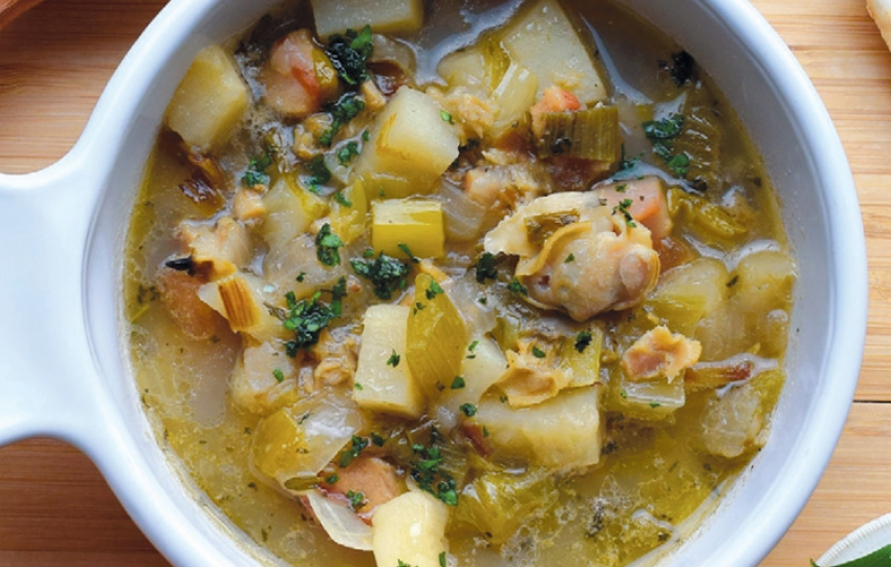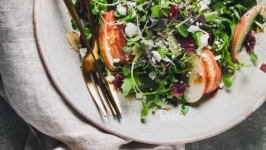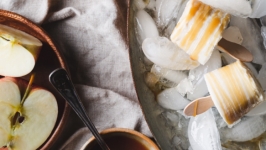Ingredients
- 6-8 ounces salt pork, diced
- 1 medium onion, diced
- 3 celery stalks, diced
- 1 large leek, white and pale green parts, sliced
- 4 cups clam broth
- 3 cups water
- 2 bay leaves
- 4 medium potatoes, cubed
- 2 cups quahog clams (chopped) and/or whole littlenecks
- 2 teaspoons fresh thyme, finely chopped
- ½-1 teaspoon Tabasco sauce
- 2 tablespoons lemon juice
- Freshly ground black pepper
- 2 teaspoons fresh parsley
Preparation
Cook salt pork in a large pot over medium heat, rendering fat. Drain, reserving cracklings and enough drippings to cook onion, celery, and leek until soft.
Add clam juice and water, potatoes, and bay leaf. Bring to a boil. Reduce heat, add clams and fresh thyme, and cook until thickened, at least 15 minutes; the longer the better. Remove from heat and let cool slightly.
Take out the bay leaf and season with Tabasco, lemon juice, and pepper. Serve with cracklings and sprinkled parsley. The potato starches will thicken the broth sufficiently, and leeks chopped into half-moons add substance and color. Quahogs are the traditional clam choice. We added whole littlenecks for texture, appearance, and sweetness.
Serves 8-10
About this recipe
A quahog is a curious thing: mouth, muscle, and shell. All it takes to coax it open is a little heat and a vat of cooperative steam. Flesh cooked and chopped, clams and liquor join the cauldron, assembled among shares of salt pork, chopped onions, and diced potatoes. Dashes of salt and pepper, fresh thyme, and crackers join, too. A good chowder is tiered: layered local ingredients, softly spoken recipes remembered and revised, many ticks of the clock. Heated through, the broth thickens, the flavors blend together. The sip is rich, the bites are complicated – texture, mouthfeel, complexity. And surprise, no milk.
These days, we rarely think about clam chowder without dairy, even though milk is a relatively new addition to the dish, originating around the north coast of New England and now popularized and codified by Campbell’s in the public imagination. Once, there was another, more popular version of clam chowder, usually called “Connecticut Chowder” in the old recipe books but occasionally “Southern New England” or “Rhode Island.” This is what some people call it today, because the Ocean State has preserved the tradition better. You might think the lack of cream would make it less rich, but you’d be wrong. This potato-thickened broth can be more intense and flavorful than the “New England” chowder, because the clam essence is not tempered with milk.
In fact, dairy was not regularly part of chowder recipes until the mid-19th century, and neither were clams. Even though fish chowder was a constant in sailors’ inns and coastal kitchens, clams were only included if they had been harvested in sufficient quantities, which was rarely. After clams began to be farmed more methodically, they became a staple in soups rather than an occasional addition. When Lydia Child describes making chowder in The American Frugal Housewife (1832), she focuses on layering the ingredients to build flavor: salt pork, potatoes – “sliced thinly as four pence” – onions, crackers, and “a few clams.” The Frugal Housekeeper (1847) by Eliza Ann Wheeler also includes clam soup, which features a knuckle of veal, but no cream. A half century later, Bridgeport ferry captain Frank Hancort used only the essential ingredients in his version: one quart of clams, steamed open with liquor reserved, a half-pound salt pork, water, sliced onions, and diced potatoes. By 1907, 1000 Simple Soups by Olive Green was one of dozens of cookbooks that contained a similar version.
In local cookbooks, on menus, and in the public imagination, clear broth remained popular all along the coast of southern New England until the mid-20th century. However, the “Connecticut” name began to disappear and fragment. By the publication of Connecticut Cooks (1982), clear broth is simply called “Clam Chowder,” separate from the New England version, with the addition of Worcester Sauce, celery, and carrots to the usual mix. The Lymes’ Heritage Cookbook (1991) has two classic cream-less recipes named for Westbrook and Mount Archer.
Although today, some restaurants in the state call it the slightly more recognizable “Rhode Island,” a few places in the state still call it “Connecticut” or by a local name. Flanders Fish Market simply calls it “clear broth,” Lenny’s Indian Head Inn names its “natural broth chowder” for the restaurant, and Costello’s Clam Shack calls it “Noank Chowder.” At Bud’s Fish Market in Branford, Hal Beckley calls his clear version “New England,” or just “Bud’s,” for his father, who prepared it in a 60-quart pot and delivered it to neighbors with a ladle. Bud used the resulting money to buy the land for this market, and Hal continues to follow the same recipe, sometimes mixing it in the same giant pot.
While we talk to Hal, a customer comes in to buy the “creamy” New England chowder, which the market makes, as well. “It’s cheaper to make the creamy one – restaurants can make it stretch by pouring the milk in,” he says. “Clear broth needs to be layered and aged. Like many stews, it’s always better after a few days in the fridge.” The next customer prefers the clear broth. “The older generation likes it,” Hal laughs, ringing her up.
“Probably our great-grandmother’s recipe,” he tells us, when asked where his father got it. But like almost everyone we talked to, he didn’t know that clear broth once ruled the Nutmeg state. There is a lesson in that. When we bring a spoonful of our own clam chowder to our mouths, we slurp a richness that’s layered with time and claim a bite of history that risks slipping into obscurity.
Bud’s Fish Market: 4 Sybil Ave., Branford; 800-348-1019
Costello’s Clam Shack: 145 Pearl St., Noank; 860-572-2779
Flanders Fish Market: 22 Chesterfield Rd., East Lyme; 800-242-6055
Lenny’s Indian Head Inn: 205 South Montowese St., Branford; 203-488-1500








